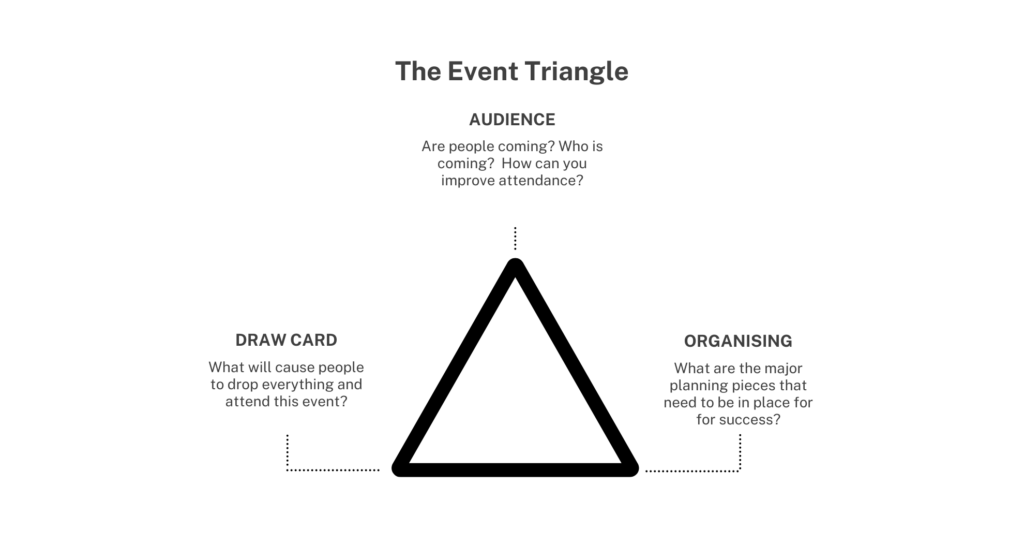Events fail in public. When this happens, reputations suffer and sponsors vanish, often never to return. Worse, attendees spread the word about the horrible experience, and spook others from attending.
Often, problems leading to event failure are preventable with better risk management techniques. In this newsletter, we look at three areas where events are prone to risk: audience, draw card and organising.

1. Audience
Without an audience, there’s no event. So, this is a critical risk area. You can break the audience up into two categories, your inner circle i.e. people you know will attend your event, and the outer circle, i.e. people likely to attend.
Your inner circle includes a trusted audience that is easy to invite. But this cannot be said about the outer circle. Most event planners use social media ads, banners, flyers, radio interviews, and other marketing techniques to reach new audiences. Our experience is that social media ads have the lowest conversion rate—around 3%. If you have a budget and enough time, this is great.
A better option is to partner with people with whom you share an audience. This can be another event planner, a venue, or another business. The goal is to get into other people’s inner circles to potentially sell tickets or fill up your event faster.
So, the way to de-risk our event is to: (1) build your inner circle, (2) partner with others to access their inner circle, and (3) advertise to broaden your reach, but as a last resort.
2. Draw Card
Even when you have an inner circle, simply thinking they will attend your event is risky. You need a draw card, a reason for them to drop what they are doing and commit to coming to your event.
More established event planners depend on popular speakers or artists to draw a crowd. But as a solo planner, you may not have the budget or sponsors to draw big artists. So, what can you do?
More and more event planners are focusing on creating an unforgettable experience. This may include the venue, the way your audience is received and treated, and their takeaway. Experiences are great, but they take a few iterations before people believe in them. One of our clients often says, “My events are an advert for the next event.”
So, how can you create a draw card with your first event? One way is to narrow down your audience so you create an us vs them. A successful example is the LGBTQI+ community — their unapologetic attitude divides people into us vs them and makes it easy for people who identify with their movement to commit.
Either way, it is risky to assume people will come. It is critical to sharpen the draw card and make it unmistakable.
3. Organising
Organising is most event planners’ strength. But left unchecked, this can be a weakness. The ability to juggle tasks does not mean doing everything yourself, it means coordinating. So, delegating to exceptional team members and partners is the key to success.
The devil is also in the details. There’s a poem by Charles Bukowski called, “The Shoelace.” In the poem, Bukowski talks about all the major things that can go wrong in our lives — divorce, murder, accidents, and so on. However, it is the small things, he says, that drive us to insanity — like bending over to tie your shoelace and then it snaps.
Apart from delegating the major tasks to competent team members, it is equally important to keep an eye on the finer details. Our experience is that creating a “Call Sheet” is also useful. In the movie industry, a call sheet is used to describe where actors and crew need to be during a shoot. It goes to every last detail, including time, place, and what each individual must do. Then it becomes the program director’s role to ensure the call sheet is followed.
Conclusion
You can create a risk profile for each area as mentioned above, then systematically de-risk the event until you are comfortable. An easy way is to rate each area out of 5, in terms of how comfortable you are. For instance, out of 5 how comfortable are you with filling up the venue? Think carefully about what could go wrong and how you can mitigate each risk. Then go ahead with the event only after reaching a score of 4 or 5 for each area.
What do you think of this approach? Looking forward to your views.

